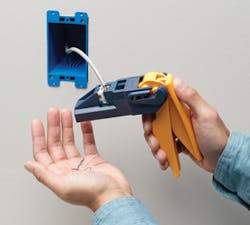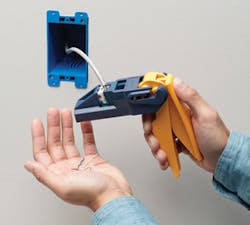Five big reasons to upgrade your punchdown tool
New tools make for faster and easier termination, and reduce re-work.
By Paul Alexander, Fluke Networks
Over the past several years there has been a large amount of new cable deployed to meet the increasing demands for greater bandwidth. Fortunately for the cabling professional, the market is responding with punchdown tools that make a molehill out of the mountain of today’s cabling options, by making the job faster, easier and better ergonomically. If you still have not expanded your technician’s tool sets, here are five reasons to invest in multi-wire punchdown tools.
1) Terminate more cable
When installing cabling, the most commonly used tool is a single-wire punchdown tool. These tools terminate one wire at a time, and can be used on all categories of cable. However, the utility of a single-wire punchdown tool is mitigated by the inability to terminate more than one wire at a time—a real problem as demand increases. Given the preceding “cable boom,” technicians are terminating increasing amounts of cable, and those working on large-scale installation jobs often struggle to keep up with the workload.
Technicians using multi-wire punchdown tools are capable of installing Category 5e/Category 6 cables—the most common type—eight times faster than technicians who are not, according to Fluke Networks’ internal research. Although multi-wire punchdown tools cannot terminate all types of jacks or blocks (as can a single-wire tool), they are essential for technicians working on large-scale jobs that often use only one manufacturer’s jacks or blocks.
2) Speed it up
An obviously corollary to increased volume, of course, is greater speed. Like the manual punchdown process, with a multi-wire tool the technician must first strip the outer cable jacket and follow the correct wiring scheme while dressing all eight wires in the respective slots. However, with one trigger pull on the multi-wire punchdown tool, each is seated and cut for a solid termination. The handle is then released and the jack is removed from the tool. One pull, eight wires terminated.
3) Increase accuracy
Another notable benefit is greater accuracy. While manual termination and single-wire punchdown tools certainly provide proper termination, a technician terminating the 200th cable of the day is not likely to be as accurate as he or she was earlier in the day. Many experienced technicians struggle with consistently terminating cables properly. In fact, we conducted a study of 50 technicians over a three-month period, for jack-error rates when seating and cutting 2,000 Category 5 and Category 6 cables. The study showed those manually terminating jacks were required to re-terminate eight percent of the time. Those using a multi-pair termination tool were required to re-terminate less than one percent of the time. Proper termination of cable is the lifeblood of any network. Improper termination can result in network downtime, repeat reports and wasted technicians’ time and resources.
4) Reduce fatigue
Decreased hand fatigue is another critical factor of multi-wire punchdown tools. Hand fatigue can be a critical issue, especially for technicians assigned to large job sites. According to the Occupational Safety and Health Administration (OSHA), “between 1999 and 2002, more than 30 percent of all employee compensation claims from the Independent Electrical Contractors (IEC) were related to ergonomics. This amounted to more than $10 million in claims in just four years.” (Source: OSHA, “Solutions for Electrical Contractors”) When any conductor is punched down, force is required to seat the conductor. That force is derived either from a technician (using their hand to manually seat the conductor), or through the use of a non-impact tool. The basic impact tool has a spring-loaded head that is compressed by the installer. Once the spring reaches full compression, it is automatically released and the force is transferred to the head of the impact tool, which then seats the conductor.
By comparison, advanced multi-wire tools can terminate all eight wires with one squeeze. This relieves a technician from having to manually punch down every single conductor—a daunting task on a site where there may be hundreds or thousands of cables to install.
5) Improve usability
In addition to other benefits, newer punchdown tools offer features such as ergonomic, easy-to-use handles, built-in beds that help hold jacks in place, replaceable blade heads for use with multiple jack types and a design form that allows for easier close-to-wall installation. All of these components will help improve the tool’s usability across a wide range of settings and requirements.
The right tool can make the life of a technician so much easier when installing and maintaining cable, and result in a wealth of savings. Each technician or operation should evaluate their workload and what formats of cable they frequently encounter in order to determine which tools will suit their work best, and maximize jobsite efficiency.
Paul Alexander is marketing product line manager with Fluke Networks (www.flukenetworks.com).

